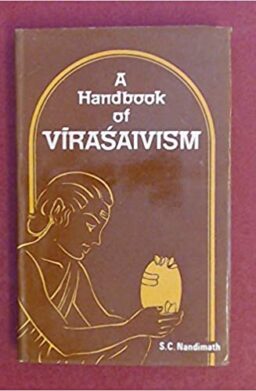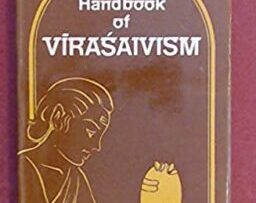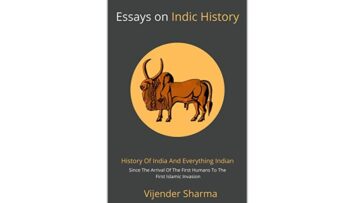Marxist dominance on the academia had ensured a resistance among scholars for any serious study and research on religion, theology and religious institutions. Hence, we are indeed fortunate to have an exception; this book by Dr. SC Nandimath, a reputed scholar and educationist on the origins, literature, philosophy, rites & rituals, metaphysics and mysticism of Veerashaivism or Lingayatism. The book forms a part of his Doctoral thesis for University of London.
Traditionally, our gnosis or the knowledge of our roots, culture, religion or philosophy used to be transferred from generation to generation. But the advent of Colonialism and the demands of modern life have interrupted this stream. Today, there is a renewed interest to know these, at least among the educated. Sadly, those interested to learn, have to make do with bits and pieces available on cyberspace, mainstream media or social media. In the case of Virshaivism too, the absence of readily available handy comprehensive literature has made enthusiastic seekers to attempt an understanding of Virshaivism based on a limited number of popular vachanas (poems) of the Sharanas (seekers or mystics). This has resulted in a specious comprehension of Virshaivism that it is just a moral science or teachings of good conduct, similar to Confucianism, an understanding no doubt as superficial as equating to Christianity with just the 10 commandments. What follows is that the philosophical, spiritual, mystical and metaphysical contents of Virshaivism remain unexplored. Thence, a need is felt for a book which explains an entire spectrum of the philosophy and practice of Virshaivism. That’s where this book fits in, though it was written as far back as in the 1940s!
Evidently the book is a product of exhaustive study, research of the vast Virshaiva literature viz, Vachanas of Sharanas, including Basavanna, painstakingly complied in Vachanshastra Sara by Dr PG Halkatti (Vachana Pitamaha), Karana Hasuge of Chenna Basava, Shaivagamas and texts of Tantricsm, epigraphical inscriptions found at Hooli Matha, Nesargi and Mangoli, followed by a critical examination of the theology, metaphysics and practices of the sect.
Regarding the origins of Virshaivism, the author finds that one of the Southern Schools of Saivism (probably Lakulisa-Pasupata or KalaMukha Sect); long existed in the Kannada Country was under distress (probably because its followers were prosecuted by the dominant Jainas ref; Basava Purana) and it was revived and reformed by a band of inspired Seekers in the 12th century led by Basavanna. This revived and reformed Shaiva School is known as Virshaivism, or more popularly, the Lingayata or Lingavanta sect.
Mythology says Virasaivism goes back to a period prior to Creation or Srishti by Brahma (ref; Suprabhedagama, Pasupatagama, Virashaiva Dharma Sindhu, Virashaivachara Kaustubha). In each Yuga, Virshaivism is re-established and preached by a batch of five Acharyas (Panchacharyas). Revana, Marula, Ekorama, Pandita, and Vishvesvaraare are the Panchacharyas for Kali Yuga. The Virshaivas trace their gotras to these Acharyas.
There is a brief introduction of 27 Sharanas or major Virshaiva writers starting from Jedara Dasimayya (1040 AD) to Shadaksharadeva (1655 AD). Sharanas-men and women belonging to all sections of society-talk about only one Supreme–Shiva, worship of the Ishtalinga, and Ashtavaranas and Sadsthala-Siddhanta in their vachanas.
Virashaivas firmly believe in one Supreme God – Shiva, the One without a second..Basavanna says, “.To speak of two Gods is false. KudalaSangamadeva is the only God. The Vedas say, There are no two Gods!” Sharanas strongly protest against polytheism. That said, it’s noteworthy that each Sharana conceived the personality of God (Shiva) so as to suit personal likings and imagination, without the least opposition from others, and with full liberty for his conscience. This aspect points to the insignificance attached to form in Virshaivism. In the words of Ananda Coomaraswamy, “How many various dances of Shiva are known to His worshippers I cannot say. No doubt the root idea behind all of these dances is more or less one and the same, the manifestation of primal rhythmic energy” (Dance of Shiva). However, the Sharanas commonly conceived the form of Shiva as it was represented in the Puranas. The idea seems to be to approach the unknown through the known. The conception of God in Virshaivism is not a whit below the standard of the Shaiva Siddhanta as they both resemble one another in their description of God. Dr S.C Nandimath says, the spirit of the early Tamil Shaiva Saints permeates the vast Kannada Literature called the Vachana Shastra.
A Unique and celebrated feature of Virashaivism is the Ishta-Linga, the emblem of the Supreme, to be worn always on the body. It is Shiva, present in each of us in the form of Chetana. The author dispels the misconceptions of orientalists / indologists about Linga being a phallus symbol or of being a miniature of Buddhist stupa. A Virshaiva does not distinguish the Linga from the Supreme or Shiva; they are one and the same. A Virashaiva must always wear the Linga on his body; he believes that the Linga removes the inclination towards evil inherent in man (Prakrti-svabhava). Further, Virasaivism, believes that each of us have three bodies; the Karana-tanu, Causal body; the Suksmatanu, subtle body; and the Sthulatanu, gross or material body and the Linga becomes three-fold corresponding to each body. There are six steps, Shadsthalas, in path of God realisation, each Sthalahas a corresponding Linga; one Linga becomes six-fold in accordance with six Sthalas.
Ashtavaranas or the eight coverings, clothings, emblems, or marks, are the practices unique to Virashaivism. The author aptly calls them as Aids to Faith. The Virshaivas rejected sacerdotals and ritualism given in Brahmanas (codified in Shrauta and GruhyaSutras). Instead; the Virshaivas developed their own rites, viz the Ashtavaranas. (1) the Guru: The spiritual guide who initiates (diksha), (2) the Linga: the emblem of the Supreme God who resides in everyone in the form of Chetana (3) the Jangama: a person of a religious order, a wandering ascetic, (4) the Padodaka; literally means the water from the feet of the Guru, hence ‘holy water’ (5) the Prasada: an object/food blessed by the Guru. (6) the Vibhuti: ‘holy ash’ prepared by burning of cow dung mixed with vegetable ingredients accompanied by chanting of Mantras, (7) the rudraksha: sacred seeds (believed to be dear to Shiva). (8) The Mantra: Namah Shivaya, the Panchakshara Mantra and Om Namah Shivaya, the Sadaksara-mantra. ViraShaivas further have their own rites & rituals from KalasaSthapana to Linga-Deeksha, Marriage, Vibhuti Vile and final rites which are officiated by Jangamas. Virshaivas are obliged to follow Panchachara or five right conducts. The book explains these rites, their symbolism & significance etc. with appropriate references to the Virshaiva literature.
Like other Bharatiya Darshanas (schools of thoughts) such as Shaiva siddhanta, Trika and Pancharatra, Virashaivism also believes in the role of Shakti in the Creation. The Universe is created by Shiva for his sport (Leela) while Shakti originates in Shiva and after that by her inherent power she becomes two, namely Kala-shakti and Bhakti-shakti. Each one of them issues further six sub-shaktis corresponding to six sthalas. Virshaivas believe, that Kala-shakti is Maya, also called Avidya, “that which causes an attachment to the objects of the world” which is the great gulf that separates Shiva and Jiva”. Virshaivism, like Advaita Vedanta, Trika, asserts the unreality of the Samsara; it attributes the cause or origin of Samsara to Avidya, which appears to be used in the same sense as in Sankara’s Advaita. However, Virasaivism starts with the belief in the reality of the world, but this reality vanishes gradually as the individual soul ‘Jiva’, advances spiritually. The soul ‘Jiva’ is nothing but the Supreme Being under limitations ‘avidya’; therefore, its limitations are to be removed to attain union with Supreme.
Sri Chennabasava (nephew of Basava) who became the spiritual head of the Virshaiva order of monks (Viraktas) after Prabhudeva (Allamaprabhu), in his Karana-Hasuge, explains the Virshaiva view of creation (Srishti) & dissolution (Laya) of universe, from void (Shunya) to Niranjana Brahma. One can see semblance with the Rgveda (X. 129), Chandogya VI. 2.1, and Taittiriyopanisad II. 7 as also Kathopanisad II. 5.15. The construction of the physical body of beings (Pindanda) is based on the model of the Universe. The body (Sharira) is built up of 75 Gunas. In addition to these there are also 25 Tattvas, which altogether serve the purpose of the self (Atma) [Atma or Anga covered with Avidya is Jiva]. Chennabasava declares that this ancient scheme is directly handed down by Shiva in Vijayabhairavi, a sub-Agama of the Paramesvara Agama. Prabhudeva in his Srishtiya Vacanagalu, describes about 25 tattvas of Anga, 11 tattvas of Linga which make 36, the exact number as in the Shaiva siddhanta but names and meanings differ. Chennabasava describes in detail pranayama and other Yogic practices as well as anatomy, physiology and the essential factors in the physical body of beings, in great detail.
Distinguishing feature of Virshaiva Metaphysics is the Gradualism of Sadsthalas, i.e. the Path of God realisation or Pilgrims Progress through six stages or Sadsthalas. Sthala- a Sanskrit word meaning “place”- has its own unique connotation in the Virasaivism. Sharanas like Maggeya Mayideva and Shivayogi Shivacarya, give a metaphysical and monistic meaning to Sthala; it is the Brahma itself, the source of all, from which the whole universe with its movable and immovable objects, has emerged. However, in common practice, Sthala is used in the sense of ““stage”, “step” or ‘halting place’ for the soul on its spiritual journey; and each Sthala is a preparation for a further rise. First is the Bhakta-Sthala, a stage in which the soul ‘Jiva’ remains as Bhakta or devotee and starts its seeking. From that stage, it rises to Mahesvara-Sthala, then to Prasadi-Sthala. These 3 are Kriyatmakashtalas meaning some action is enjoined on the Virshaiva. The next 3 are PranaLingisthala, SharanaSthala and AikyaSthala, they are called Nivrutti or Jnana sthalas. In Aikya-sthala, Jiva achieves union with Shiva. Evidently, Sthalas are solely of spiritual significance meant for purifying the self (Jiva) by removing Avidya, the starting-point (Bhakta Sthala) is indicated by the appearance of a desire to seek. Needless to say, each Sthala has its Vrata, Niyama & Sheela as well as its own corresponding Linga & Shakti.
Vrata, Niyama and Sheela in the Vachana Shastra means righteous conduct viz to abhor covetousness, shun violence and to be equanimous. The Virshaiva saints laugh at those who undertake the severe vows of fasting and other forms of penance involving physical hardships.
The dogma (core faith) of Virshaivism; Shiva is the Supreme and He is the One, to be worshipped as the Linga, worn on the body. The aim of man’s spiritual endeavour is to realize Shiva in himself. Its Rituals are the Ashtavaranas, and Panchachara whereas its Philosophy is Gradualism of journey through Sadsthalas. The destination of Aikya with Shiva, is also conceived as becoming one with the Bayalu or Nirbayalu, the final ineffable void (Shunya).
Democratic spirit of Virshaivism empowers everyone to pursue the Path to Shiva irrespective of caste and gender. Mysticism is weaved into everyday life, and Path to God is interpreted as a process of becoming; to be achieved in this very life. Spiritual endeavour and the business of life is harmonized by blending man’s spiritual and social lives together.
The Ultimate belief of Virshaiva is “merging of Soul (Jiva) in the Supreme( Shiva), it begins with the belief in the distinctness between the two; to efface this distinctness, the soul (Jiva) has to climb six steps- Sadsthalas.” As a Sharana says “The soul is of the nature of light. . . There is no distinction between the soul and the Paratpara-Brahman. [Vacana Sastra Sara, pp. 476-477; 485]. This may have influenced Sripati Pandita, in his Srikara Bhashya to call Virshaivism as Vishesadwaita- ‘Monism with its own special belief’. According to Virasaiva philosophy, the world is neither ultimately real nor ultimately unreal. It looks real at the start but becomes unreal at the end. The Linga, is nothing but the unity of flaming light which underlies all states and existences. As Mahadevi Akka says, “not merely the wood or the trees are God but also the beasts of prey and the fowl of the air which inhabit them”
Commenting on the most famous vachana of Sri Basavanna, AK Ramanujam [Speaking of Siva p.20] says, “The poem draws a distinction between making and being. The rich can only make temples. They may not be or become temples by what they do!” This exactly is the essence of Virashaivism- start the seeking by being a temple to Shiva and then proceed to be one with Shiva (Aikyasthala) – is succinctly conveyed in the book.
Dr. S.C Nandimath’s book is a brilliant conspectus, interesting and helpful for anybody who wants to know about Virshaivism and also for those who have already travelled some distance on this path. It serves as an excellent guide for any keen researcher or for a serious academic pursuit. The philosophical tenets, the metaphysics and mysticism in Virshaivism are explained in easy comprehensible words and critical comparisons made with other schools of thought such as Shaiva Siddhant, Trika, Panchratraand Advaita Vedanta. The book is a must-have in every Virashiava home, a must-read for the young and old to have a right understanding of their faith.
Study of the book divests the reader of the popular misconception that Virshaivism is a reactionary response to prevailing social evils or corruption in religious life, and invests the reader with an understanding that Virshaivism is revolutionary and transformative.
The author’s ability to go beyond academic interpretation of texts and to construct thoughts into a synoptic whole is evident throughout. Presumably, this comes out of his living the life of a Virshaiva rather than it being just an academic pursuit. To borrow words of Dr. R.D. Ranade, “His chapter on the “Pilgrim’s Progress” is an interesting monument of the aspirations which a true Virasaiva must cherish in his heart.”
The book limits itself to literature, philosophy, rites and metaphysics of Virshaivism and omits the socio-political and economic aspects. The outstanding feature of Virashaivism has been its zeal for social reform. What the Sharanas, led by Sri Basavanna, preached and practiced was no less than a social revolution. This in course of time grew into a movement for an egalitarian society. The book doesn’t cover the wider impact of Virshaivism on contemporary society as well as its effect on the present society in SouthIndia. This book provides a foundation or primer on Virshaivism, on which scholars can study and write on these aspects, as evident in, ‘Revolutions of the Mystics’ On the social aspects of Virshaivism’ by J P Schouten or in ‘Shunyasampadane’(5 Vols) by Dr. S.S. Bhoosnurmath.
The book manages to be reader-friendly and handy, it may not be lyrical like AK Ramanujam’s, ‘Speaking of Śiva’, but it is a pleasant read that achieves its purpose; of being a Handbook for gnosis as well as practice of Virshaivism. The chapters are succinct and precise like a physics text, they give just the essential knowledge and direct the reader to annexures for further study. This format is convenient to common reader interested in having just a basic idea of Virshaivism as against a deeper expertise of a scholar.
During the 1940’s (or prior), rest of India and Western world had nil or meagre awareness and understanding as to what is Virshaivism and its place in the socio-religio-cultural journey of Bhartiya civilizataion. This is the first book to introduce Virshiavism, to the English-speaking World. Importance of this book in its time, cannot be better expressed than Dr. R.D. Ranade, “Work on the subject of Virasaivism so as to give to that system of thought a dignity and a place which it deserves in the entire scheme of Indian thought.” Its importance is no less in current times to dispel the popular superficial understanding of Virshaivism.
The book is out of print, but available on https://archive.org/details/in.ernet.dli.2015.208450
Disclaimer: The opinions expressed in this article belong to the author. Indic Today is neither responsible nor liable for the accuracy, completeness, suitability, or validity of any information in the article.









